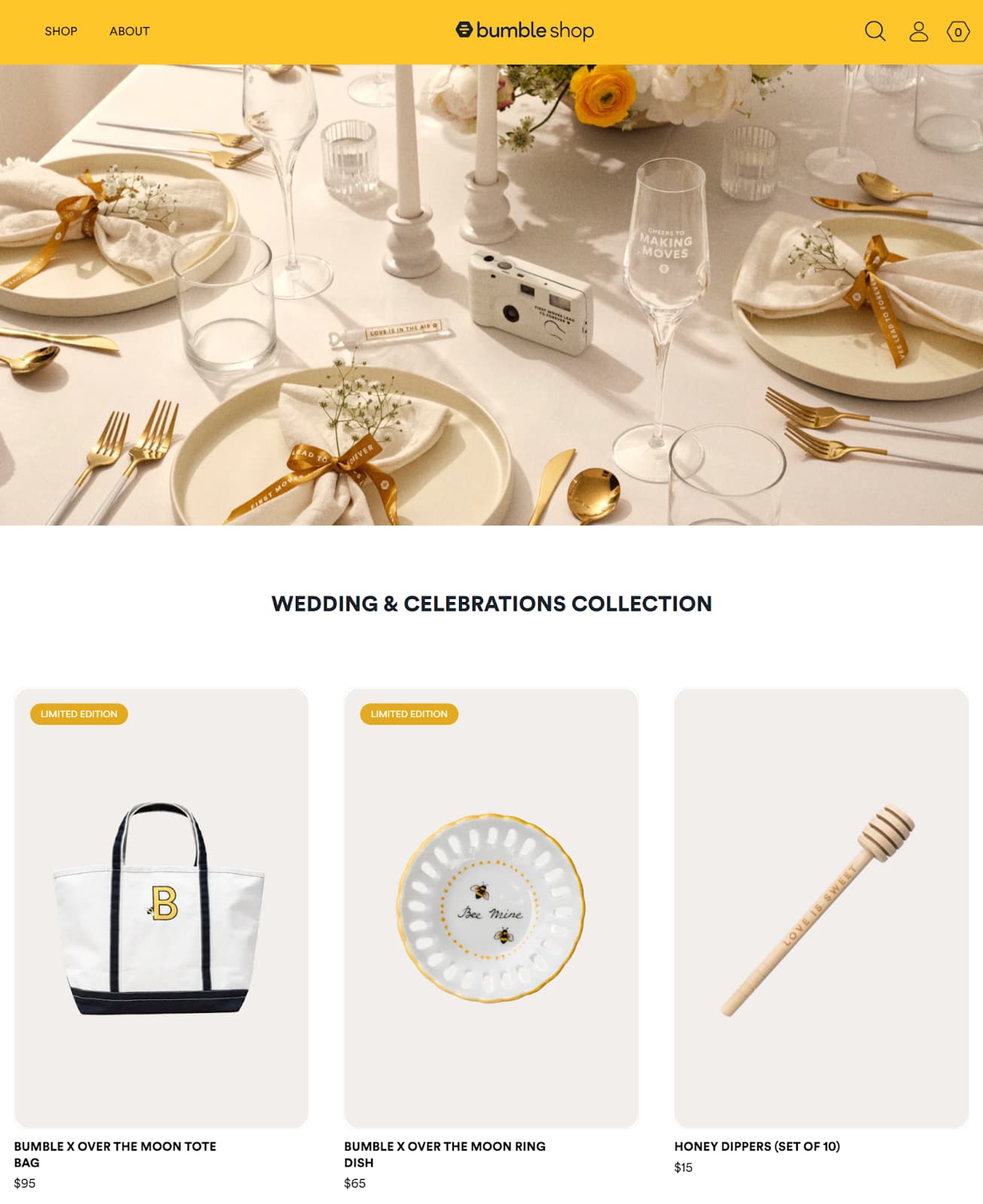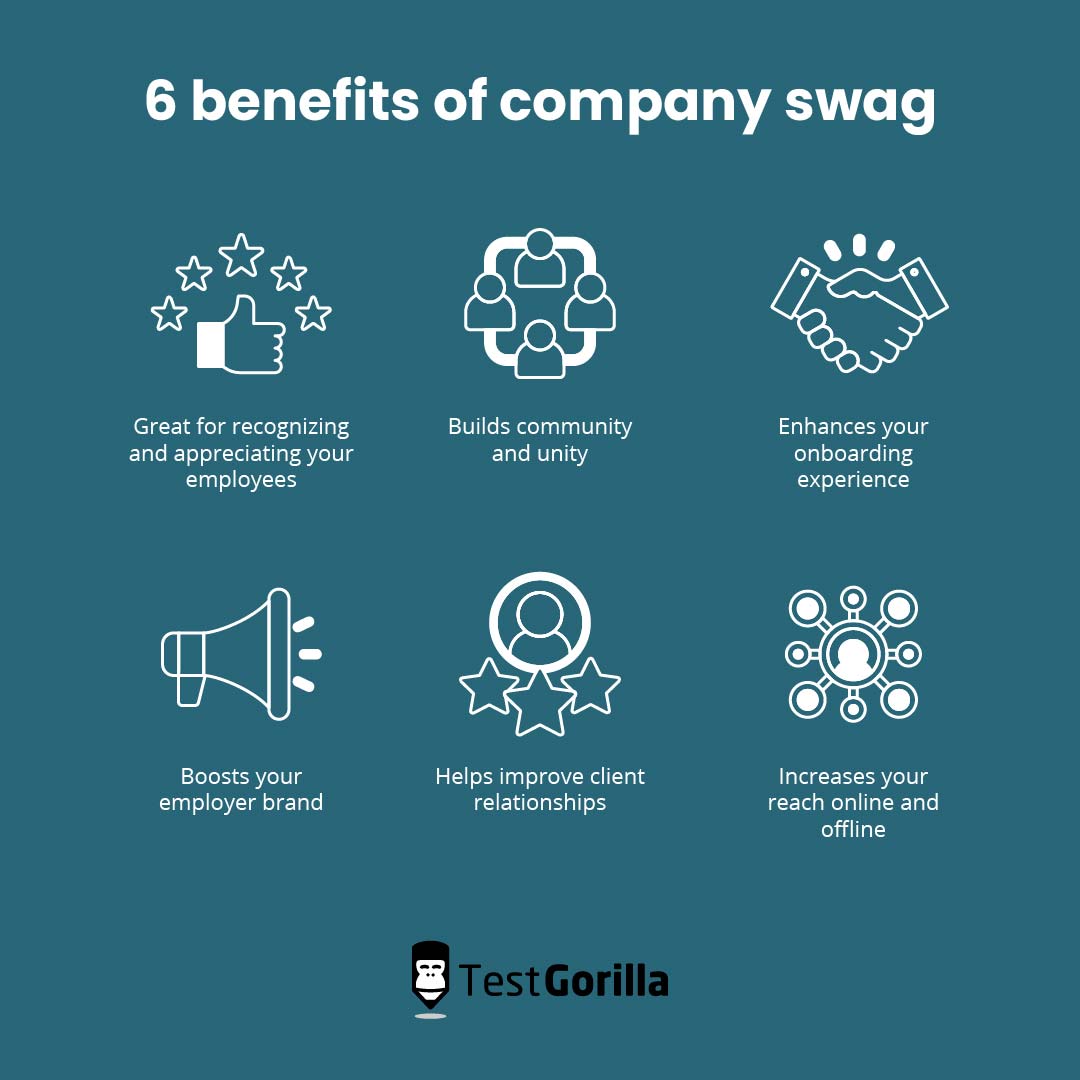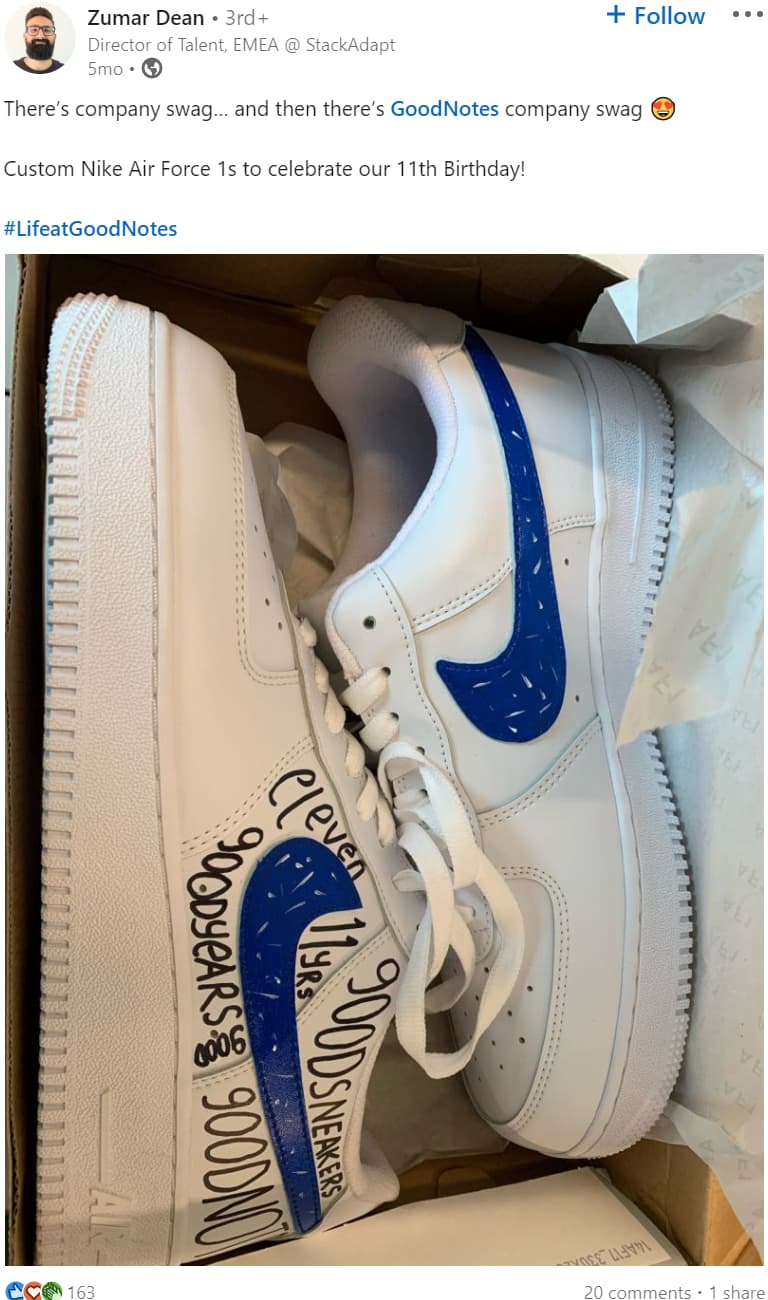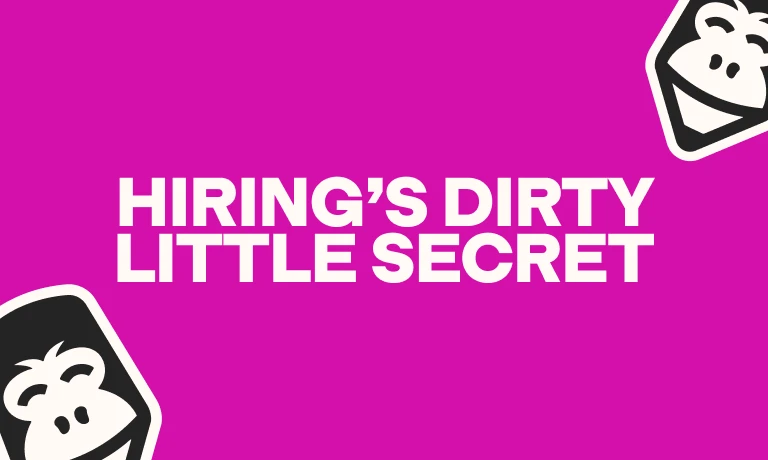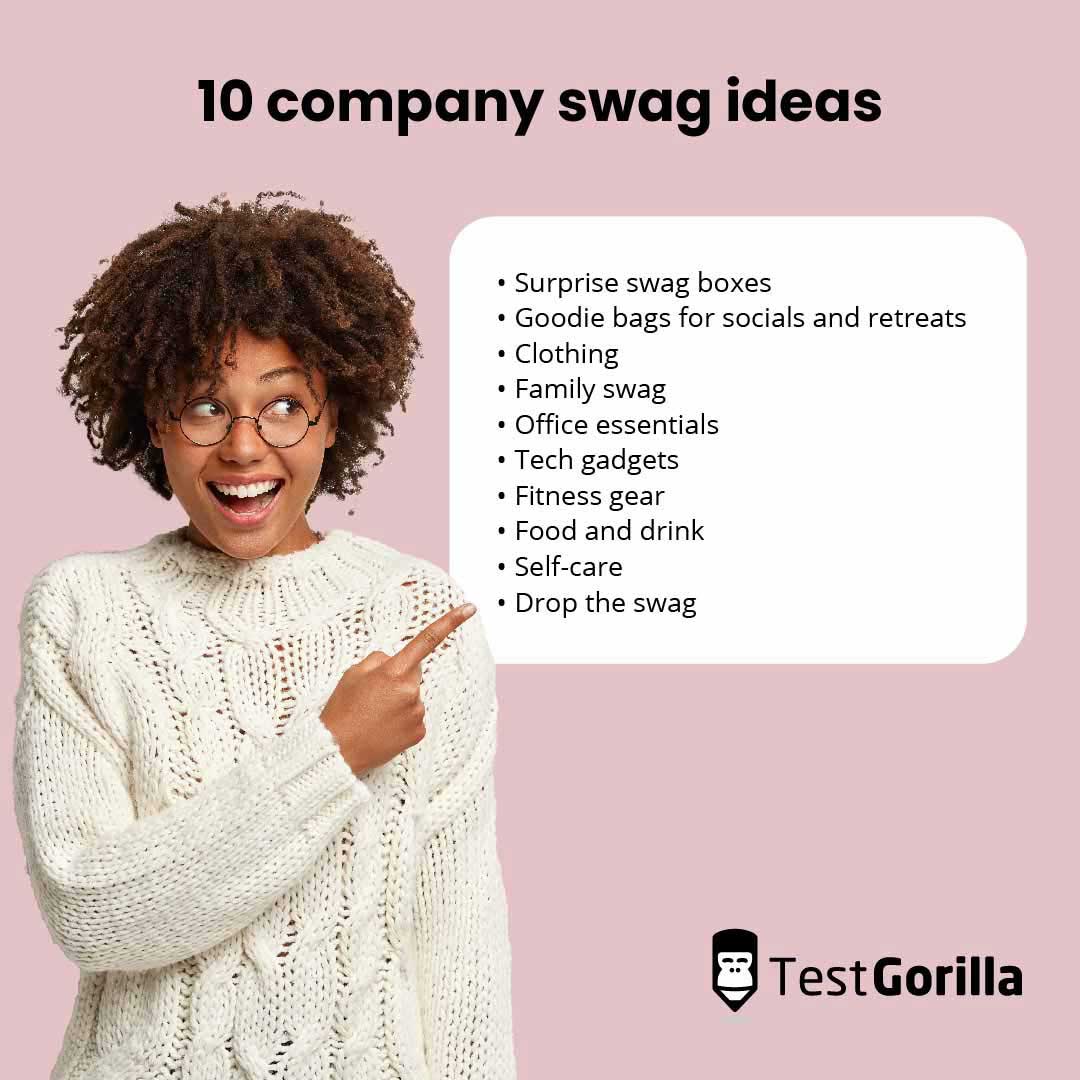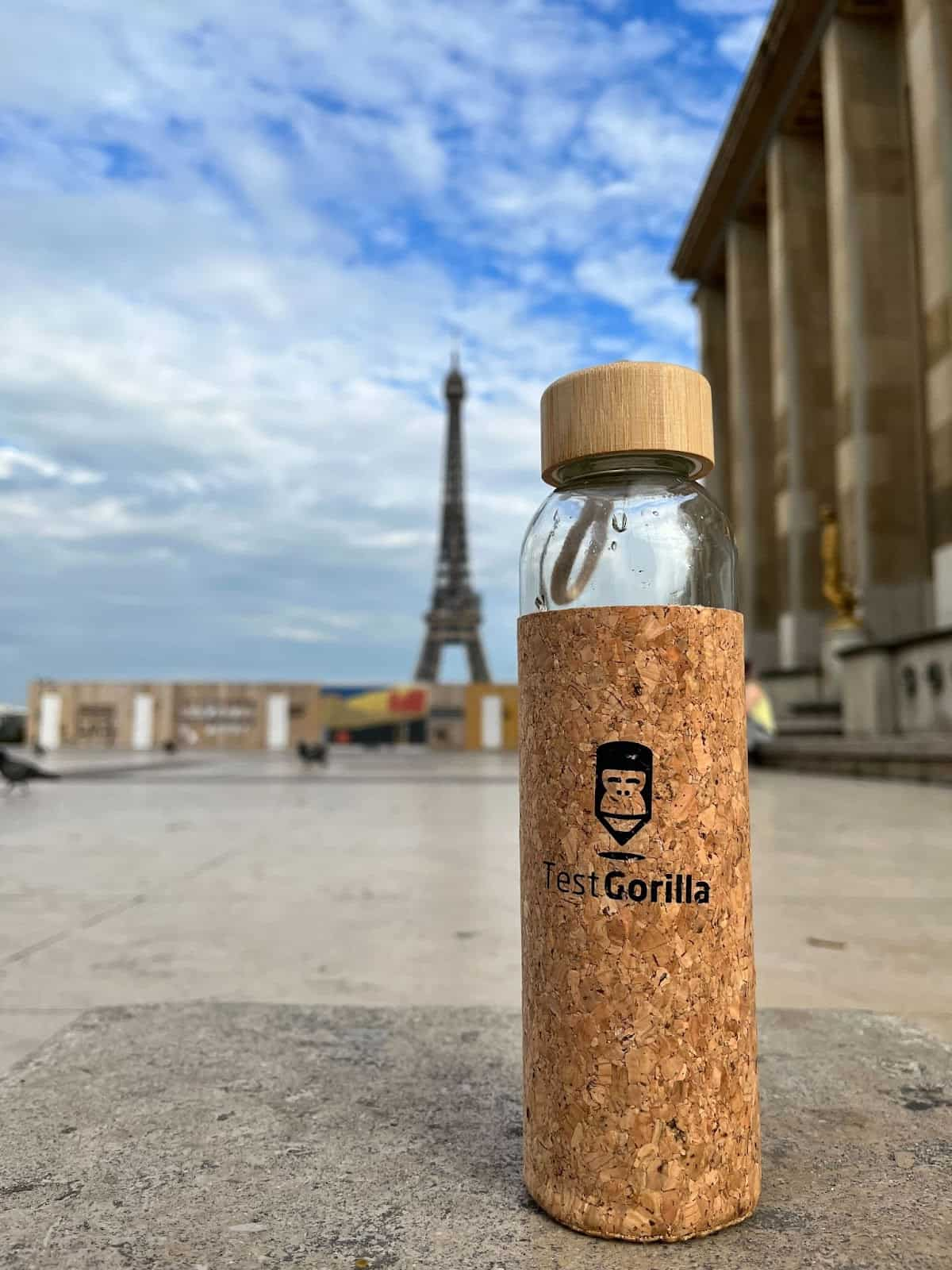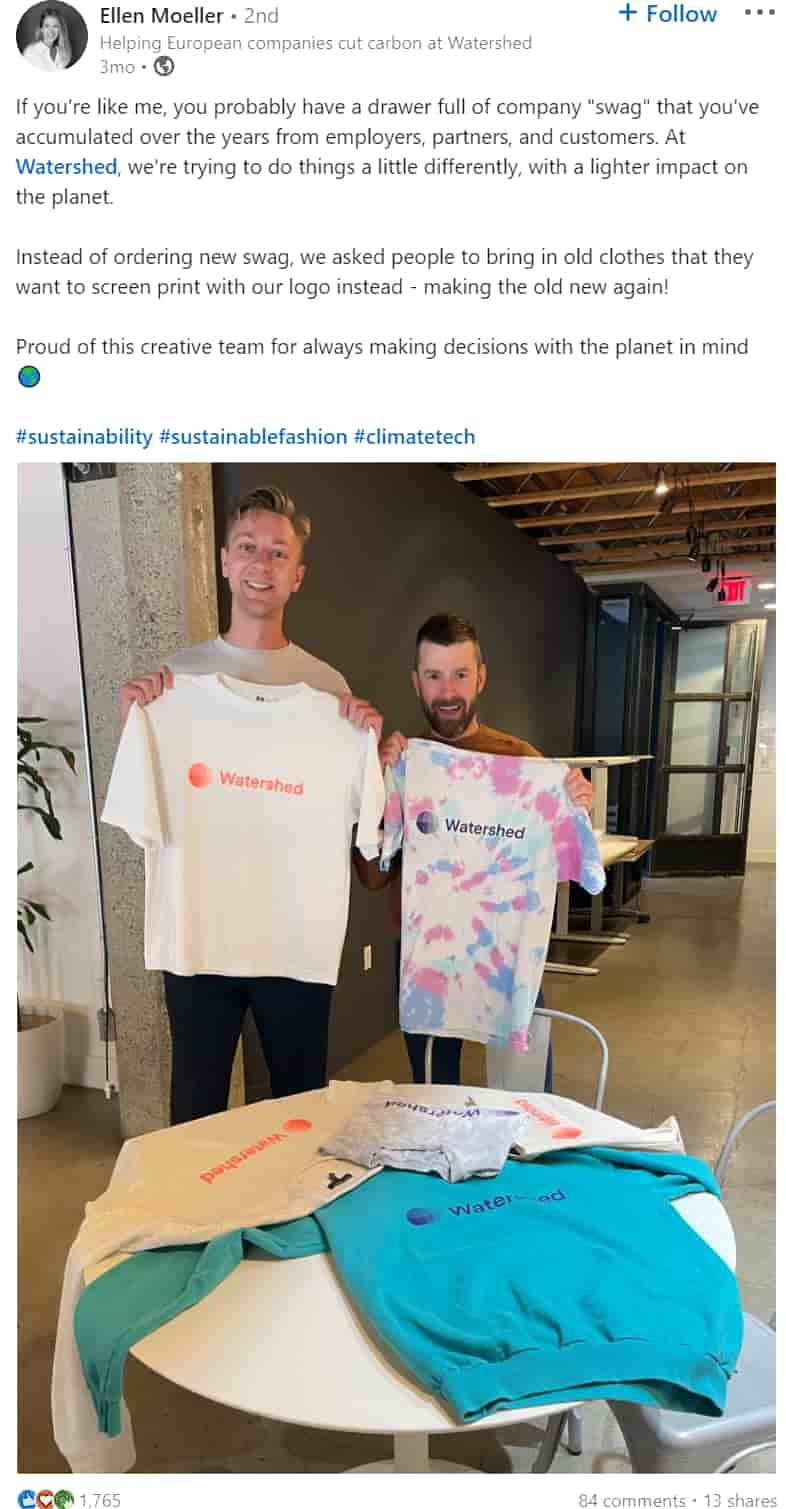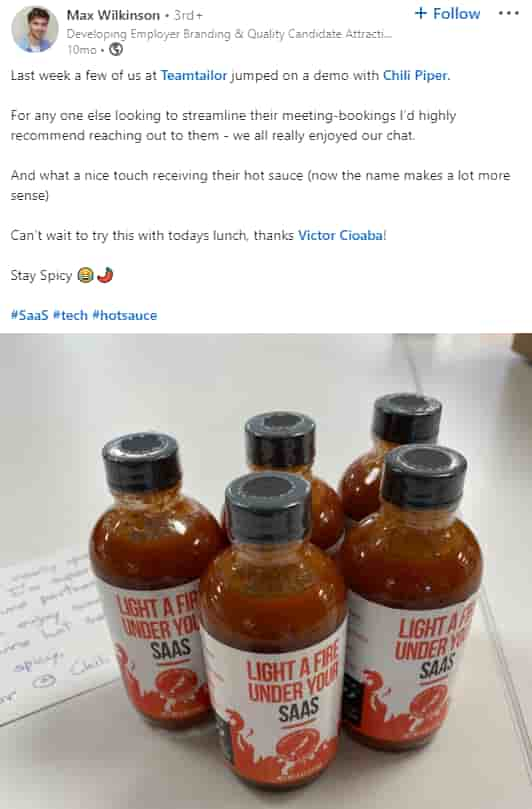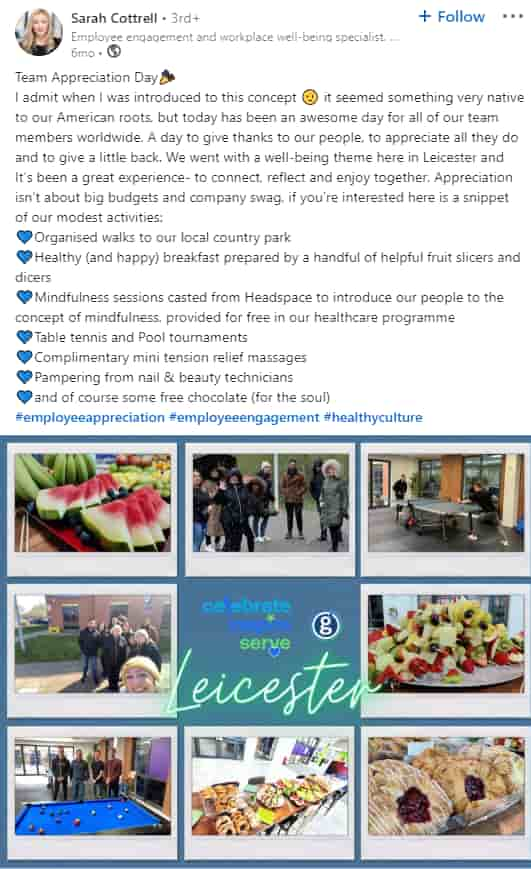We’ve all got stories about bad company swag.
Branded T-shirts seemingly designed by someone with no knowledge of human proportions…
Electronics that started smoking when plugged in and went straight into the trash…
And tote bags. So many tote bags!
At its best, company swag helps celebrate your brand and create a cohesive culture among employees. But at its worst, it’s just more useless stuff destined for a landfill.
So how do you make sure your company swag is a success and not just future trash?
In this post, we’ll go through the benefits of company swag for your business and share ideas on how to implement it the smart way.
What is company swag?
Company swag – more boringly known as “promotional items/products” – refers to free merchandise given out by businesses as a way to popularize their brand.
It’s designed to integrate your company branding into everyday life, amplifying your message to more people and creating positive associations with your organization.
It’s not a new idea. Perhaps the first example of company swag in US history was created by none other than George Washington, who gave out promotional buttons for his 1789 presidential campaign.[1]
But it’s now almost ubiquitous in corporate life. A study by ASI found that nearly a third of all employees aged 35 to 54 have promotional products in their homes.[2]
Who is company swag for?
Simply put, company swag is for everybody, but your approach to it will need to change depending on whom you’re giving it to. You usually give corporate swag to these groups:
Employees: to foster a sense of belonging.
Corporate clients and industry contacts: to establish a bond.
Influencers: to encourage them to share your brand with their followers.
Let’s not forget:
Customers: to cement their loyalty to your brand and broadcast it to their friends and family. Here’s a fun example of how the dating app Bumble did this.
This blog post will mainly focus on company swag for employees and corporate clients.
6 benefits of company swag
With so many bad examples of company swag out there, it might seem like it’s more trouble than it’s worth. But what are the benefits of creating company swag for employees and business contacts?
1. Great for recognizing and appreciating your employees
When it’s done right, company swag can be a great way to show your employees that you value them and reward them for good performance.
Gift-giving is one of the five appreciation languages you can use to foster a positive experience among employees, a key practice for employee engagement.
In fact, 71% of organizations with highly engaged employees recognize employees when they do a good job, compared with just 41% of less engaged businesses.[3] So, giving company swag items is a great way to show employee appreciation.
2. Builds community and unity
Swag builds community. That’s why sports teams wear uniforms and music fans buy band tees.
This community-building creates a supportive environment for your employees to work in. Many studies show that building a positive workplace culture helps reduce staff turnover and can even protect your business against the Great Resignation.
For example, one report showed that 9 out of 10 workers who consider their work culture to be poor have considered quitting, compared with just 32% of employees at organizations with a good culture.[4]
3. Enhances your onboarding experience
Giving new employees welcome gifts as part of a strong onboarding program can be an effective way to celebrate their entry into your team and help them feel at home.
It’s especially helpful for virtual onboarding processes, in which remote employees might find it more challenging to establish a bond with their new employer.
Improving your onboarding process aids overall retention: Employees with a poor onboarding experience are twice as likely to seek different employment in the near future.[5]
4. Boosts your employer brand
Creating a positive candidate experience from the get-go not only helps retain existing employees but can also attract new ones.
A study found that 87% of employees report that their organization’s recognition programs are either stale or used as a form of disguised compensation.[6] It follows that integrating company swag into a strong employee engagement and recognition program can help boost brand awareness and set you apart from these lackluster competitors.
5. Helps improve client relationships
Enabling your sales and client relationships teams to give out company swag bags can sweeten the deal with new partners and keep your business front of mind as they consider their options.
Although, as an HR manager, you might not be the one giving out those gifts, it’s your job to make sure that they match your overall brand. The results can be powerful: A survey by Cartwright & Butler found that 85% of businesses said their corporate gift-giving strategy strengthened valuable relationships.
6. Increases your reach online and offline
Once upon a time, company swag was primarily used so that people would see your clients and employees using it in real life and be reminded of your brand.
Nowadays, your custom swag has an even larger reach, thanks to the internet. Creating brilliant branded merch can inspire employees and clients to post about your brand on social media, introducing you to potential customers and clients.
The benefits of company swag: summary table
In a rush? Here are the headlines.
Recipient | Benefits for your business |
Employees | Rewards them for positive performance; Makes them feel valued; Creates a sense of unity and community |
Corporate clients | Sweetens the deal when considering their options; Keeps your brand front of mind |
Influencers | Helps get your brand’s message out to a larger audience; Increases the likelihood that they’ll mention you for free in future |
Customers | Enhances their loyalty to your brand; Broadcasts their brand loyalty to their whole network |
The best insights on HR and recruitment, delivered to your inbox.
Biweekly updates. No spam. Unsubscribe any time.
The key to company swag: Make it relevant and fair
The golden rule of creating effective company swag is to tailor the company swag you give out to the recipient.
We can’t emphasize this point enough. The best company swag is useful, desired, or both. Without at least one of these elements, there’s no incentive for people to use your company swag, and it could even damage your reputation. No one thinks highly of the company that:
Gives a hat to Larry, who never wears hats
Gives an extra-large sweatshirt to their 5’5” marketing manager
Gives a whole stationery kit – complete with compass and calculator – to a content writer who will only use the pen
They’ll think you’re another one of those companies that just does swag because it’s become business as usual – a bit like your distant relative who sends you socks for Christmas.
Ensure that your employee swag, and the way you allocate it, is fair. You can’t give sports fans a branded yoga mat and music fans AirPods.
Likewise, avoid favoritism when it comes to who gets the company swag. The sales team swanning around in branded sports caps while everyone else has none is hardly a recipe for company unity. It could even create tension.
How to make sustainable swag
When we say that bad swag ends up as trash, we don’t necessarily mean that it gets thrown out immediately. According to a PPAI study, 79% of consumers pass along products that are no longer valuable to them, for example, by donating them.
However, in the case of clothing, the majority of donated clothing ends up in a landfill. Perhaps it doesn’t go directly into the trash, but it’s likely on its way there.
The advice in this post will help you make sustainable choices by tailoring your company swag to your audience, but you should also consider using sustainable suppliers for your swag. The ASI study we mentioned earlier found that almost half of consumers had a more favorable view of an organization if they received environmentally friendly swag.
Here are a few ways to make your swag sustainable:
Give employees a list of options for their swag so that no one gets anything they won’t use
Use sustainable materials in the manufacturing process
Commission local manufacturers to limit emissions
Embrace upcycled swag (more on this later)
We’ll include tips throughout this article on making each swag option more sustainable. Now, let’s get into it.
10 company swag ideas
Now that you know the general best practices for creating cool company swag, it’s time to dive into some specific ideas and examples. Here are 10 company swag ideas to help build your brand visibility and company culture.
1. Surprise swag boxes
A surprise swag box can be a great way to offer a pick-me-up or celebrate a milestone, especially for remote employees.
Just make sure to order several variations and do some research on the recipient. This way, you can give the right box to the right person.
For example, you might give a branded headset to a remote salesperson who does loads of calls but swap this out for a desk calendar containing important national holidays for a social media manager.
Remember, creating a branded goodie box is an ideal way to underscore your company’s core values. If you pride yourself on sustainability, you could ensure that your goodie box is made of recyclable or compostable materials and delivered by carbon-neutral couriers. A little thought can go a long way.
2. Goodie bags for socials and retreats
Company swag is particularly effective when you connect it to positive memories, like company socials and retreats.
We don’t have to look far for examples here. Our team at TestGorilla is fully remote, but each year we hold an offsite retreat for all employees, complete with team-building, sightseeing, and – you guessed it – goodie bags.
By giving our team useful items for the trip, we not only help cement the face-to-face bonding experience but also provide mementos for everyone to take away when returning to remote work. We highly recommend taking a similar approach.
Here are some other practical items you can include in your socials or travel swag kit:
Hand sanitizers
Face masks
Wireless chargers (more on tech later)
3. Clothing
As we mentioned above, clothing is one of the biggest offenders when it comes to landfill junk. However, there are ways you can avoid this.
Firstly, ensure the clothing fits your company culture and style. It makes sense to produce company swag like T-shirts, hoodies, jackets, and beanies if you have a casual dress code. However, company-branded socks might be safer if your business has a more formal dress code.
You should also prioritize producing high-quality, durable, and versatile items. No one wants cheap clothes made in sweatshops. They’re bad for everyone, from the manufacturers to your employees to the environment.
Furthermore, using a blatantly harmful manufacturing process can be catastrophic for your reputation. The PPAI study we cited above also revealed that 72% of people believe the quality of promotional products reflects the organization’s reputation.
The design of your clothing is also important. People don’t like feeling like a walking billboard, no matter how much they like their employer. This is why three out of four employees prefer swag that doesn’t have an obvious business logo on it.
Our final tip is that clothing offers one of the best opportunities for low-impact recycled swag.
For example, you could invite employees to bring in their old clothes to upcycle into fun company swag.
4. Family swag
We believe that swag should be celebratory. When an employee at your organization starts to grow their family, company swag boxes are a great way to show parents that you support them.
But before you whack a logo on a babygrow and put together a gift set, take a moment to think about what would be most useful for the new parents in your workforce. Here are some things to consider:
Most parents will already have received a ton of clothing for their baby’s first six months – and nothing for afterward. Consider giving them clothes in the 6-to-12-month range.
Likewise, many parents will read parenting books well before birth, so assume that they have read the newborn books and plan ahead.
Create swag that’s not just clothing related. For example, you could create branded accessories, like pacifiers or baby bottles, or activity packs for a day at the beach.
5. Office essentials
This is one of the most common company swag categories we’re sure everyone is familiar with. You know the drill: You open a package from your employer, and it’s filled with:
Notebooks
Pens
Mousepads
And hey, there’s nothing wrong with that. They’re called “essentials” for a reason. But it’s still worth thinking about what your employees actually use day to day and what will be most useful to them.
A salesperson or content writer might use a pen, but they might never use a calculator, ruler, or whatever other stationery items you see fit to give them. Likewise, most developers plan their projects using digital tools, so a desk diary won’t help them much.
Again, opt for recycled products when you can. Even if sustainability isn’t a big part of your business persona, it can earn big kudos when shared online.
6. Tech gadgets
When it comes to branded tech, our number one tip is to make sure that the swag you give out actually works. Nothing shows a lack of effort like headphones that break after the first use, and once again, this is more plastic that will end up in a landfill.
You should also consider whether you’re giving your employees real value. In this day and age, chances are they already have a gadget they swear by, whether that’s a favorite pair of headphones or an ergonomic mouse.
Instead of taking a chance on tech itself, choose useful tech accessories your employees are less likely to have already or something extra they wouldn’t mind owning, for example:
Cable organizers
Flash drives
Bluetooth speakers
Portable chargers
Power banks
Tech swag is also an opportunity to integrate company swag with setup support for working from home during the onboarding process. Give new recruits branded items to support their home office, and bundle these with deliveries, such as comfortable office chairs and standing desks.
7. Fitness gear
Fitness gear is one of the best options for company swag. Although fitness enthusiasts might have a strong rotation of their favorite workout gear, many of us are still jogging in our old pajama shirts and would welcome a free, high-quality sports gift from our workplace.
Fitness swag is especially useful for supporting well-rounded employee well-being programs. For example, you might use it as part of a company-wide 5k, daily steps challenge, or charity fun run, showing employees you’re invested in their health and productivity.
8. Food and drink
Food and drink are among the most popular choices for company swag, and for good reason. Waste is limited because it’s all edible, and it can help facilitate team bonding experiences, even remotely.
For example, you might deliver employees meal boxes to prepare together in a Zoom cooking class. Or you could send employees happy hour boxes before a remote social event (after checking that the recipients all drink, of course).
Alternatively, you could send out coffee or tea kits and accessories to give remote and hybrid workers the office experience in the comfort of their homes.
Company-branded utensils also fall under this umbrella. Reusable water bottles, tumblers, eco-friendly straws, coffee mugs, and other drinkware are great gifts for your employees and the planet.
(Pro tip: For an extra boost, deliver these alongside wellness tips, such as how much employees should be hydrating and how often they should be snacking to avoid burnout.)
If you’re lucky, there might be a way to tie your snacks with your branding and make waves on social media, like the SaaS business Chili Piper.
9. Self-care
Perhaps your business has just gone through a stressful transition period or one of your teams has put in late hours to get a project over the line. Self-care packages can show your employees that you care about their health, wellness, and happiness outside the workplace. Some self-care gift ideas include:
Sleep masks (along with guidance about maintaining a healthy sleep schedule)
Hand cream
Lip balm
Hot and cold packs
Candles
10. Drop the swag entirely
Finally, and perhaps most controversially, we suggest you think about ditching the company swag entirely.
As we recommended above, giving employees a choice about the swag they receive is one of the best ways to ensure your company swag is sustainable and appreciated by your team. You should also give them the option to receive no swag at all.
It sounds counterintuitive, but consider giving employees the option to donate their swag budget to a charity of their choice. You might even get them to compete to win money for their nominated charity, for example, with a bake sale.
If charitable giving doesn’t tempt you, consider investing in experiences instead of objects. For instance, you could send your teams on a well-being day consisting of activities like guided meditations, spa treatments, and bonding exercises.
Both of these company swag alternatives deliver many of the same results – like showing employees that you care – but without unnecessary waste. They may even post about your generosity on social media, which would be another win.
10 company swag ideas: summary table
Here’s a table for a handy guide on the swag ideas we discussed above.
Swag category | Tips | Examples |
Surprise swag boxes | Create different boxes for different teams or functions; Let your employees choose what they receive | Work-from-home kits for new employees |
Goodie bags for socials and retreats | Give out the bags at the start of the trip so that employees can use them all throughout it | At TestGorilla, we gave out reusable water bottles and tote bags on our yearly retreat |
Clothing | Fit the clothing to your company dress code; Use ethical manufacturers; Don’t go overboard with logos; Upcycle employees’ existing wardrobes | Host a tie-dye and printing workshop to upcycle employees’ old clothes |
Family swag | Don’t just focus on the first six months for babywear; Create activity boxes or branded accessories, not just clothing | A goodie box for a day at the beach |
Office essentials | Only give employees things they’ll use in their day-to-day jobs | Give a social media manager a desk diary with important national holidays highlighted |
Tech gadgets | Make sure that all your gadgets work for your employees and if they already have tech they love, give them accessories instead | Cable organizers; Flash drives; Portable chargers |
Fitness gear | Use fitness gear as incentives for well-being programs | Organize a company fun run complete with a branded running kit |
Food and drink | Consider allergies, intolerances, and preferences; Tie into activities like remote socials | Send out meal boxes for teams to prepare over Zoom in a remote cooking class |
Self-care | Deploy after stressful periods for your organization; Accompany with guidance on how to maintain good self-care | Lip balm; Hot and cold packs; Candles |
Drop the swag | Give your employees a vote on whether to receive swag; Give money to charity instead; Organize a well-being day instead of swag | Employees compete in a bake sale to win the swag budget for their nominated charity |
Use swag to build a positive work culture
When poorly done, company swag is destined for the dusty corner of employees’ closets and, ultimately, the trash.
But when you do it right – with consideration for employees’ habits and preferences as well as the environment – and integrate it into your onboarding and employment processes, company swag helps you foster a vibrant and supportive culture.
If you’re ready to start growing that culture, check out our onboarding checklist.
Or take a look at our Culture Add test for assessing job applicants.
Sources
“History of political buttons”. York University Libraries. Retrieved October 20, 2022. https://archives.library.yorku.ca/exhibits/show/pushingbuttons/history-of-political-buttons
“Global Ad Impressions Study 2020 Edition”. (2020). Advertising Specialty Institute. Retrieved October 12, 2022. https://media.asicentral.com/resources/2020-Global-Ad-Impressions-Study.pdf
Du, Connie. (June 25, 2019). “State of Employee Engagement in 2019: 4 Key Points”. Bonusly. Retrieved October 12, 2022. https://blog.bonus.ly/the-state-of-employee-engagement-2019
“Global Culture Research Report | 2020”. SHRM. Retrieved October 12, 2022. https://www.shrm.org/hr-today/trends-and-forecasting/research-and-surveys/Documents/SHRM%202022%20Global%20Culture%20Report.pdf
“What the CIO sees—that other people don’t”. Super CIO. Retrieved October 12, 2022. https://docs.wixstatic.com/ugd/0cbe87\_664f8806dc694bd7b52246c2e0fe41c1.pdf
“Recognition | Global Culture Report”. O.C. Tanner. Retrieved October 12, 2022. https://www.octanner.com/global-culture-report/2021/recognition.html
You've scrolled this far
Why not try TestGorilla for free, and see what happens when you put skills first.



